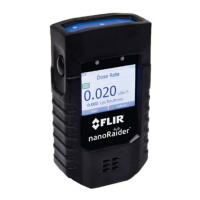FLIR Detection 6. FLIR identiFINDER R300 Menu Reference
Send
Save the spectrum and go to Send Spectrum (see 6.22, p. 140), avoiding the detour around the
normal options menu hierarchy. The current spectrum will be already chosen for sending.
Preset
Go to the Presets (see 6.8, p. 121), avoiding the detour around the normal options menu hi-
erarchy.
6.3 Calibration
Options Menu (p. 103) ä More Options (p. 103) ä Spectrum (p. 106) ä Calibration
The calibration check screen (Figure 122, p. 116) shows a zoomed spectrum (see 6.2, p. 106)ofa
certain peak and some parameters describing the peak. The center of the horizontal axis is posi-
tioned at the theoretical peak position and the vertical axis is scaled logarithmically.
Upon entering this screen, a peak of
137
Cs is shown. You can choose other nuclides from a list of
nuclides commonly used for calibration (Table 1, p. 115).
Table 1. Typical Calibration Peaks
Nuclide Peak [keV]
137
Cs 661.65
40
K 1460.8
232
Th 2615
22
Na (ANNH) 511 Annihilation radiation also originates from other
sources like
11
C,
13
N,
15
O,
18
F,
68
Ga, or
82
Rb.
54
Mn 834.838
60
Co 1173
241
Am 59.54
238
U (DU) 1001
235
U (HEU) 185.7
Refer to Appendix C, p. 259 for details about the nuclides.
Make sure the source selected to be checked is present when using this command.
For best results, move the instrument to a low-radiation environment to check the calibration.
Data for this spectrum are continuously acquired beginning with an empty spectrum upon entering
this screen or after you cleared the data (see below).
Settings and Commands
Nuclide
The nuclide used for the calibration check, refer to Table 1, p. 115.
identiFINDER
®
R300/en/2014.4(13623)/Feb2015 115

